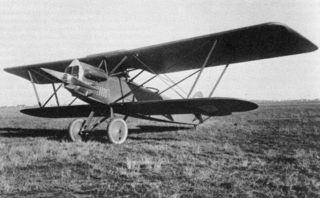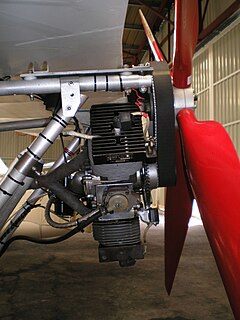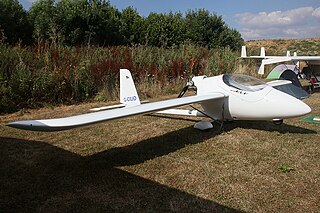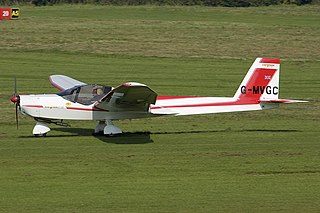Related Research Articles

The Aero A.30 was a biplane light bomber and reconnaissance aircraft built in Czechoslovakia in the late 1920s. It originated as an attempt by Aero to improve the performance of the Aero A.11, but soon evolved into quite a different aircraft, larger and more powerful than its predecessor. The aircraft is readily distinguished from other related types by the difference in spans between its wings – the upper set being of much greater span than the lower.

The Blériot-SPAD S.46 was a small French airliner of the 1920s, developed from the Blériot-SPAD S.33. Like its predecessor, it was a conventional biplane that seated four passengers in an enclosed cabin while the pilot and occasionally a fifth passenger rode in an open cockpit. The S.46 had a redesigned wing of longer span and a far more powerful engine. The type was employed by Franco-Roumaine, which purchased 38 out of the 40 examples produced for use on their continental European routes.

The Chasle YC-12 Tourbillon ("Whirlwind") was a single-seat light sporting aircraft developed in France in the mid-1960s and marketed for homebuilding via plans. It was a low-wing cantilever monoplane of conventional configuration. As designed, it featured fixed tailwheel undercarriage, but it could also be fitted with fixed tricycle gear.
The Partenavia P.59 Jolly was an Italian two-seat training monoplane designed by Partenavia to meet a requirement for the Aero Club d'Italia.
The Zenair Zipper is a Canadian ultralight high-wing, single seat aircraft that was designed by Chris Heintz and produced by Zenair.

The Robin ATL is a French two-seat light aircraft designed by Avions Robin in the 1980s to meet a need for an economical two-seat aircraft to equip flying clubs. It is a single-engined monoplane with a fixed tricycle undercarriage, conventional control stick, and is, unusually, fitted with a V-tail. Due to the large bubble canopy, visibility is excellent. Its benign flight characteristics, moderate speeds and low fuel consumption, as well as some unique details, like an engine starter button which can only be pressed when the fuel selector switch is open, made the ATL a good trainer.

The König SC 430 is a three-cylinder, two-stroke, single ignition radial aircraft engine designed for powered paragliders and single place ultralight trikes.

The Dyn'Aéro MCR4S is a four-seat development of the French two seat, single engine Dyn'Aéro MCR01. It first flew in early 2000 and is sold as a kit for homebuilding in several versions by SE Aviation of Pontarlier.
The AeroKuhlmann Scub is a single engine, high wing utility aircraft built in France in the 1990s.
The Dedalus Poppy is a homebuilt, single engine, single seat ultralight aircraft flown in Italy in the 1980s. Several were built and flown; at least one remains on the Italian civil register in 2010.

The Radab Windex is a family of Swedish high-wing, single-seat aerobatic gliders and motor gliders that was designed by Sven Olof Ridder and produced initially by Radab and later by WindexAir AB as a kit for amateur construction.
The Alpaero Sirius, also called the Noin Sirius, is a French high-wing, strut-braced, pod-and-boom, cruciform tail, single-seat motor glider that was designed by Claude Noin and produced by his company, Alpaero of Châteauvieux, Hautes-Alpes. It was available as plans for amateur construction and also as a kit, but has been discontinued.
The Latécoère 225 was an unusual single seat canard microlight amphibian, with a swept wing, and of pusher configuration. It first flew in 1984 but was not put into production.
The MFI BA-12 Sländan is a single seat ultralight of pod and high boom configuration and with a butterfly tail. It was designed and built in Sweden in the 1980s and led to a two-seat, slightly larger, development called the BA-14.

The Aurore MB 02 Souricette is a French ultralight aircraft, designed by Michel Barry and produced by Aurore Sarl of Sauvagnon. The aircraft is supplied as a kit or as plans for amateur construction.
The Aérostructure Lutin 80, earlier known as the PLM 80, is a small, single seat motor glider with a low power pusher configuration engine, designed and built in France in the 1980s. Only two were completed.

The Ekolot JK 01A Elf is a Polish mid-wing, single-seat motor glider, designed by Jerzy Krawczyk, produced by Ekolot of Krosno and provided as a complete ready-to-fly aircraft or as a kit for amateur construction.
The Chasle LMC-1 Sprintair is an all-metal, single-seat sports light aircraft designed in France in the early 1970s and intended to be built by aero clubs from plans.

The AMF Chevvron is a British two-seat microlight aircraft of the 1980s and 90s. It is a single engined mid-winged monoplane with side-by-side seating. 41 were built.
The Chasle YC-10 Migrateur was a single seat sports aircraft built in France in the early 1980s. Only one was built and it flew for less than 30 hours.
References
- 1 2 3 Taylor, John W. R.; Munson, Kenneth (1988). Jane's All the World's Aircraft 1988-1989. London: Jane's Information Group. p. 520. ISBN 0 7106-0867-5.
- 1 2 Taylor. Jane's All the World's Aircraft 1988-1989. pp. 684, 689.
- ↑ Partington, Dave (2010). European registers handbook 2010. Air Britain (Historians) Ltd. pp. 691, 1171. ISBN 978-0-85130-425-0.